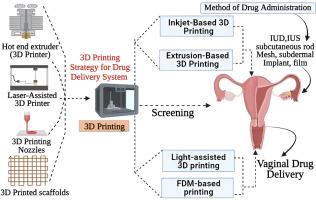用于阴道给药的 3D 可打印定制给药系统:打开妇女护理的潜在前景
Q3 Medicine
引用次数: 0
摘要
当前传统给药方法的特点是普遍采用 "一刀切 "的方法,这给根据个体药代动力学特征定制药物带来了挑战,限制了其在制药领域的适用性。为此,随着熔融沉积建模(FDM)或增材制造(AM)技术的发展,用于阴道给药的三维(3D)可打印医疗器械越来越受欢迎。与传统的给药方法相比,这些设备具有明显的优势,可以实现药物的定制,并创造出具有个性化设计的复杂三维结构。另一个值得关注的问题是,多材料打印技术的发展整合了多种功能物质的有益特性,为提高阴道给药的疗效提供了多种机会。虽然制造工艺有了长足的进步,但成本效益、可扩展性和法规遵从性等挑战仍然是巨大的障碍。本综述重点介绍了利用三维技术印制阴道给药装置领域的最新进展,探讨了需要克服的主要挑战,并探讨了制造技术在塑造未来剂型和给药系统方面的潜力。本文章由计算机程序翻译,如有差异,请以英文原文为准。

3D printable customized drug delivery system for the vaginal delivery of therapeutics: Unlocking potential prospects for women care
The current traditional medication administration method is characterized by a prevalent "one-size-fits-all" approach poses challenges in tailoring medications to individual pharmacokinetic profiles, limiting its applicability in the pharmaceutical sector. In response to this, three-dimensional (3D) printable medical devices for vaginal drug delivery are gaining popularity, due to advancements in Fused Deposition Modeling (FDM) or additive manufacturing (AM) technology. These devices offer distinct Strengths over conventional medication delivery methods, enabling the customization of drugs and the creation of intricate three-dimensional structures with personalized designs. In an additional point of interest, the development of multi-material printing integrates the beneficial properties of a variety of functional substances, presenting diverse opportunities to enhance the efficacy of vaginal drug delivery. Although there have been substantial advancements in manufacturing processes, challenges such as cost-effectiveness, scalability, and compliance with regulations remain substantial hurdles. This review focuses on the recent progress made in the field of printed using three-dimensional technology for vaginal medication delivery devices, addresses the primary challenges that need to be overcome, and explores the potential of manufacturing techniques in shaping the future of dosage forms and drug administration systems.
求助全文
通过发布文献求助,成功后即可免费获取论文全文。
去求助
来源期刊

Annals of 3D printed medicine
Medicine and Dentistry (General), Materials Science (General)
CiteScore
4.70
自引率
0.00%
发文量
0
审稿时长
131 days
 求助内容:
求助内容: 应助结果提醒方式:
应助结果提醒方式:


